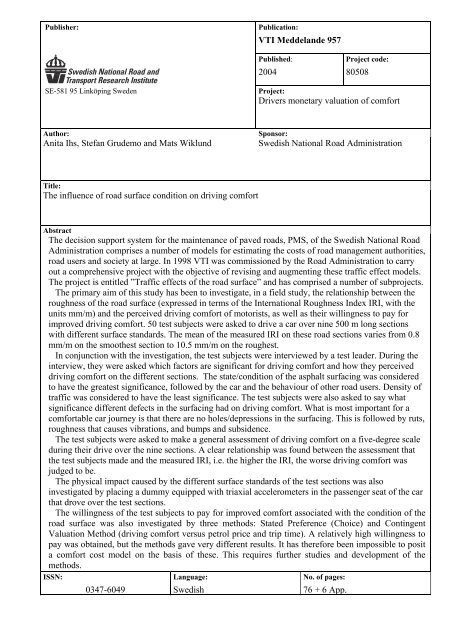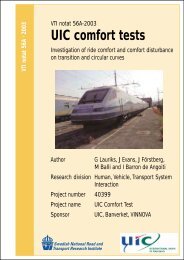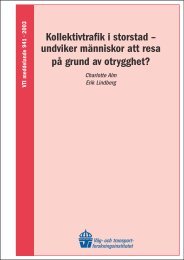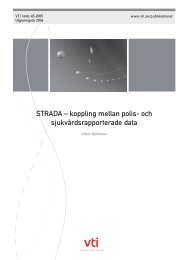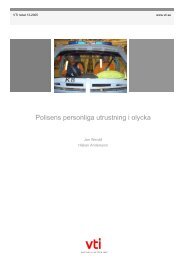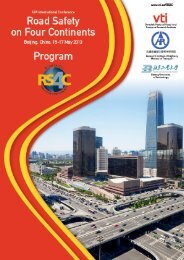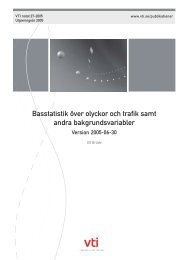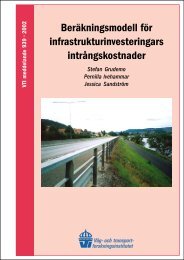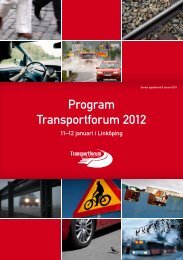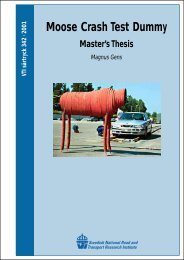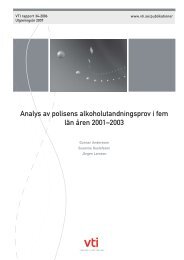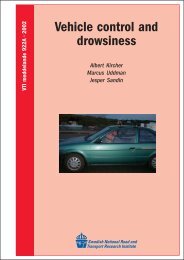Forskningsområde - VTI
Forskningsområde - VTI
Forskningsområde - VTI
- No tags were found...
Create successful ePaper yourself
Turn your PDF publications into a flip-book with our unique Google optimized e-Paper software.
Publisher:Publication:<strong>VTI</strong> Meddelande 957Published:2004Project code:80508SE-581 95 Linköping SwedenProject:Drivers monetary valuation of comfortAuthor:Anita Ihs, Stefan Grudemo and Mats WiklundSponsor:Swedish National Road AdministrationTitle:The influence of road surface condition on driving comfortAbstractThe decision support system for the maintenance of paved roads, PMS, of the Swedish National RoadAdministration comprises a number of models for estimating the costs of road management authorities,road users and society at large. In 1998 <strong>VTI</strong> was commissioned by the Road Administration to carryout a comprehensive project with the objective of revising and augmenting these traffic effect models.The project is entitled ”Traffic effects of the road surface” and has comprised a number of subprojects.The primary aim of this study has been to investigate, in a field study, the relationship between theroughness of the road surface (expressed in terms of the International Roughness Index IRI, with theunits mm/m) and the perceived driving comfort of motorists, as well as their willingness to pay forimproved driving comfort. 50 test subjects were asked to drive a car over nine 500 m long sectionswith different surface standards. The mean of the measured IRI on these road sections varies from 0.8mm/m on the smoothest section to 10.5 mm/m on the roughest.In conjunction with the investigation, the test subjects were interviewed by a test leader. During theinterview, they were asked which factors are significant for driving comfort and how they perceiveddriving comfort on the different sections. The state/condition of the asphalt surfacing was consideredto have the greatest significance, followed by the car and the behaviour of other road users. Density oftraffic was considered to have the least significance. The test subjects were also asked to say whatsignificance different defects in the surfacing had on driving comfort. What is most important for acomfortable car journey is that there are no holes/depressions in the surfacing. This is followed by ruts,roughness that causes vibrations, and bumps and subsidence.The test subjects were asked to make a general assessment of driving comfort on a five-degree scaleduring their drive over the nine sections. A clear relationship was found between the assessment thatthe test subjects made and the measured IRI, i.e. the higher the IRI, the worse driving comfort wasjudged to be.The physical impact caused by the different surface standards of the test sections was alsoinvestigated by placing a dummy equipped with triaxial accelerometers in the passenger seat of the carthat drove over the test sections.The willingness of the test subjects to pay for improved comfort associated with the condition of theroad surface was also investigated by three methods: Stated Preference (Choice) and ContingentValuation Method (driving comfort versus petrol price and trip time). A relatively high willingness topay was obtained, but the methods gave very different results. It has therefore been impossible to posita comfort cost model on the basis of these. This requires further studies and development of themethods.ISSN: Language: No. of pages:0347-6049 Swedish 76 + 6 App.


